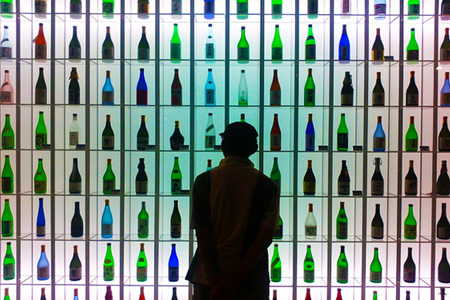Did you know that the history of sake, which is consumed not only in Japan but around the world, stretches back 3,000 years into the past? Sake, or nihonshu as it is known in Japan, is a beverage with a long history indeed.
This article provides an introduction to the origin of sake, a history of the ways in which it has been consumed, and an explanation of the changes it has undergone up to the present day. By learning about the history of sake, you will find a new depth to its flavor.
What is the origin of sake?
It could be argued that the history of sake is the history of rice culture itself. The cultivation of rice reached Kyushu (in western Japan) around 3,000 years ago and subsequently spread to the rest of the country, and it is thought that alcoholic drinks made from rice began to be produced at this time.
The origin of sake can be found in something called kuchikamizake, meaning ‘mouth-chewed sake’. When rice is heated and then thoroughly chewed, the enzymes in a person’s saliva cause saccharification in the rice and it becomes sake. 3,000 years ago, kuchikamizake was a beverage produced as an offering to the gods, and only priestesses at shrines were permitted to produce it.
It was 1,300 years ago that a brewing method using rice malt began to spread, and planned production of sake overseen by a special government office called Sake-no-Tsukasa began. The methods of producing sake employed by different groups of people in different areas began to mix with the techniques used in the official government-produced sake, and this resulted in a variety of flavors of sake being produced around Japan.
The history of how sake has been consumed
The official government-produced sake of around 1,300 years ago was mainly produced for religious events and for the enjoyment of the aristocracy, but around 800 years ago, commoners also began to make sake and it became a drink that was consumed by the masses. It was around the time commoners began to drink sake that its consumption went beyond religious events, marriages, funerals, and celebrations to become a part of everyday life.
The introduction of a tax on sake
A tax on sake was first introduced around 680 years ago. The government of the day viewed stores selling sake as an extremely important source of income, and imposed a tax on it. Tax has been levied on sake throughout all eras since then, and it has always been treated as a source of finance for the national government.
The sake tax was revised and increased many times in the modern era from 1871 onward,
yet sake continued to be produced and consumed by many people no matter how high the tax. As a result of this, the national government’s tax income between 1868 and 1926 was comprised to a large extent from income on tax levied on sake, and this contributed greatly to the cost of the Sino-Japanese War and the Russo-Japanese War.
A modern history of sake
Sake production returns all around Japan after the war
Many restrictions were placed on the production of sake during World War II, but with the economic democratization measures enacted by GHQ after the war, the controls that had been placed on alcoholic beverages were lifted in May of 1949. In July of the same year, sake producers were able to freely ship and sell sake, and with a reduction in tax that was implemented through the Liquor Tax Act in 1953, the sake producers who had gone out of business during the war gradually made a comeback and sake began to be made all around Japan once again.
One of the things that contributed greatly to the development of sake was the mechanization of sake production between 1950 to 1973.
Whereas sake had previously only been produced in winter, mechanization made it possible for production to take place throughout the year, which in turn led to a further flourishing of sake production around Japan.
The intergenerational evolution of sake
The 1980s brought a further increase in the quality of sake, and provided the spark for a massive increase in the popularity of junmaishu and ginjoshu.
The way in which sake is consumed also changed greatly with the spread of household refrigerators. In the days when refrigerators were not common, there were, broadly speaking, two ways of drinking sake: heated and at room temperature. But the spread of refrigerators brought with it a new way of enjoying sake by chilling it prior to consumption.
One of the characteristics of sake is that its flavor changes with temperature, and heating it allows one to enjoy a dry taste while chilled sake has a sweeter flavor.
Nowadays, many people choose a method of consumption to suit their preferences, and the fact that there are a variety of ways to enjoy it is one of the things that makes sake so appealing.
Summary
This article provided a brief summary of the history of sake. Created as a sacred product around 3,000 years ago, sake has gone from being a beverage enjoyed by the aristocracy to one enjoyed by the public in general, and with the improvement in flavor brought by technological development it is now loved by many. And now that you also know about the history of sake, you might find that you enjoy it just that little bit more.
【References】
鈴木芳行(2015)『日本酒の近現代史 酒造地の誕生』吉川弘文館
吉田元(2013)『近代日本の酒づくり 美酒探求の技術史』岩波書店
酒みづき ~ 日本酒の起源はいつ?日本酒文化の歴史を紐解いてみよう
酒類総合研究所情報誌 平成26年1月第1号
http://www.sawanotsuru.co.jp/site/nihonshu-columm/knowledge/history-of-nihonshu/
日本酒造組合中央会 ~ 日本酒とは?日本酒の歴史
月桂冠 ホームページ ~ 口噛み酒 中南米・南太平洋・台湾・沖縄・大隅半島で醸された
dressing ~ 日本酒っていつから飲まれているの? 一升瓶で売られているのはなぜ? 日本酒のおもしろい歴史の話
KURAND ~ 日本酒の「冷や酒」=「常温」は今でも通じるのか?
KAWASHIMAYA ~日本酒の歴史と文化ー和を醸す酒、日本酒
蔵こん ~ 日本酒の歴史シリーズ 酒税についてその2
酒文化研究所 第24号2014年12月25日 ~ 日本の酒税制度の軌跡をたどる
KIRIN ~ 酒・飲料の歴史
菊正宗~生酛(生もと)で辛口はうまくなる ~ 第7巻 日本酒の歴史(後)
宮下酒造株式会社 ~ 今なぜ「酒税制度改革」が必要なのか(2005年5月号)
J-STAGE ~ 21世紀の清酒醸造の技術革新
解決!アスクミー ~ 海外でも人気の日本酒 なぜ日本酒が注目されているのか?
株式会社アドリンク ~ 【和食ブーム】日本酒が「日本」のお酒として世界に躍進中!
